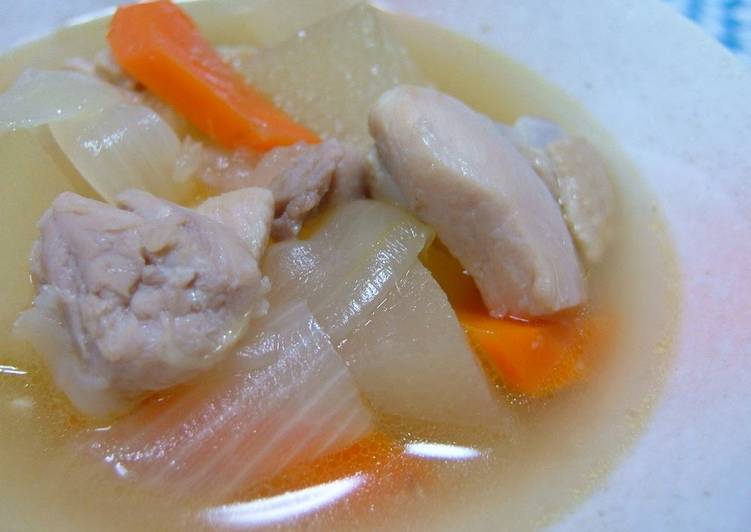Simmered Winter Melon and Chicken in Soup with Two Kinds of Dashi Stock Recipe. How to set it up? What are the ingredients? Cooking tips and more… This is one of my favourite food recipe, this time i’am gonna make it a little bit tasty.
Dashi is the special umami-forward stock that becomes the base of many Japanese dishes, such as soup There are different kinds of dashi stock, each with its own specific culinary use, but If the idea of making dashi from scratch is a bit overwhelming, there are two alternatives that are simpler. Dashi is the basic Japanese soup stock used in many Japanese dishes.
Here is the best “Simmered Winter Melon and Chicken in Soup with Two Kinds of Dashi Stock” recipe we have found until now. This is gonna smell and look delicious.
Ingredients of Simmered Winter Melon and Chicken in Soup with Two Kinds of Dashi Stock
- Prepare 1/4 of Winter melon.
- Make ready 1 small of Chicken thigh.
- Take 1/3 of Onion.
- Prepare 1/2 of Carrot.
- Take 1 tbsp of Sesame oil.
- Make ready 1 of thumb's worth Grated ginger.
- You need 2 tbsp of Sake.
- You need 1/2 tbsp of ●Weipa.
- It’s 1 tsp of ●Japanese soup stock (granules).
- You need 400 ml of ●Water.
- Make ready 1 tbsp of ●Mirin.
- Prepare 1 tsp of ●Salt.
- You need 1 tsp of ●Soy sauce.
- Prepare 1 of Black pepper or shichimi spice.
It's not just used in soups; it's used in everything, from sauces, dressings, as a liquid when stewing vegetables, and more.Without dashi, your Japanese dishes simply aren't right.This holiday has its story about two sweethearts, that's why it's called the day.The soup made with the simmered dashi had a slight sourness, while the soup made with the unboiled dashi—far and away my preferred version—left only The distinction between the two is of the utmost significance in Japanese fine dining, in which the ichiban dashi is used only in clear soups.
Simmered Winter Melon and Chicken in Soup with Two Kinds of Dashi Stock step by step
- Cut the winter melon, onion, carrot, and chicken into bite-sized pieces..
- Add the sesame oil and ginger into a frying pan, and turn on the heat to low. Fry the ginger until fragrant..
- Add the chicken, and turn up the heat to medium. Stir-fry until both sides change colours..
- When the colours have changed, add the vegetables. Briefly stir-fry until everything is coated with the oil..
- Swirl in the sake, and mix briefly..
- Add the ● ingredients, and bring to a boil. Skim off the scum, simmer for about 10 minutes over medium heat, and done!.
- It's also delicious to sprinkle on some black pepper or shichimi spice to your liking!.
- I garnished this dish with mitsuba This is also delicious!.
- When you are using chicken broth from boiled chicken, substitute Weipa Chinese chicken stock paste and water with it.
https://cookpad.com/us/recipes/143249-moist-boiled-chicken.
Now you'll have lots of chicken dashi stock in reserves to use for all your future recipes that may require it.When the water starts boiling again, turn the heat down to minimum and simmer for a couple of minutes.Dashi or stock (often called dashi stock, which is kind of redundant) is the foundation of all savory washoku.
Find stockbilleder af Chinese Cuisine Winter Melon Chicken Soup i HD og millionvis af andre royaltyfri stockbilleder, illustrationer og vektorer i Shutterstocks samling.Tusindvis af nye billeder af høj kvalitet tilføjes hver dag.The classic dashi pairs up two different types of amino-acids from the kelp and from the katsuobushi, and that combination is an umami powerhouse that acts as a flavour enhancer.A chicken broth made Japanese style can be used as substitute in some dishes, especially the ones with chicken meat.Be kind and conduct productive discussion.








